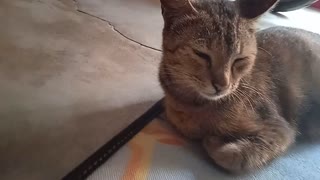Cat sleeping 😸.
If you have a cat, you may have noticed that they appear to spend a lot of the day sleeping. Your cat may also be more lively in the early morning or evening hours, perhaps even waking you from your sleep.
Even though your cat's sleep behaviors might seem unusual compared to yours, they could be completely normal for a cat. Learn more about natural cat sleeping patterns to better understand your cat, recognize when your cat is feeling less than their best, and know when it is time to call your veterinarian.
How Many Hours a Day Do Cats Sleep?
More than half of cats sleep between 12 and 18 hours a day1, and nearly 40% of cats sleep more than 18 hours per day. As they grow older, a majority of cats sleep for more hours each day than they did in their younger years.
How Long Do Cats Sleep?
Cats have a polyphasic sleep pattern2, which means they sleep multiple times each day rather than in one, long period, like humans generally sleep. These cat naps average 78 minutes in length. However, cats commonly sleep for periods of time ranging from 50 to 113 minutes3.
The Sleep Cycle for Cats
Like humans, cats have a circadian rhythm4. The circadian rhythm is the internal biological clock5 that guides the 24-hour sleep-wake schedule.
In humans, the sleep cycle is diurnal, meaning we are naturally prone to stay awake during the day and fall asleep at night. Cats, however, are crepuscular6. They experience two peaks of activity, one in the early morning before sunrise and one in the evening around sunset.
Researchers hypothesize that a cat's crepuscular sleep cycle is driven by their predatory natures. Common prey animals for cats have different sleep cycles. A cat's crepuscular nature allows it to be awake at daybreak to prey on diurnal birds, and at twilight to prey on nocturnal rodents.
What Happens While Cats Sleep?
Similar to humans, cats cycle through different stages of sleep. Cats experience both non-rapid eye movement (NREM) and rapid eye movement (REM) sleep7.
Research shows that cats often experience a period of alertness and activity8 before becoming drowsy and then falling into NREM sleep. During this NREM stage, your cat may be lightly asleep and ready to awake at a moment’s notice. After NREM sleep, the cat may become alert again and cycle through alertness, drowsiness, and NREM sleep a few times.
Ultimately in the cycle, cats transition from NREM to REM sleep. During REM sleep, the eyes move behind closed eyelids. In cats, the eyes can move both horizontally and vertically. You have probably seen your cat experience REM sleep. When cats are in REM sleep, they can twitch or go limp with a loss of muscle tone.
Also, during REM sleep, cats may dream9. In humans, dreams most frequently occur during REM sleep10. The eye movements made during REM may be linked to dreaming. Researchers have observed cats appearing to act out their dreams while in REM sleep.
-
 0:07
0:07
Rizky12
2 years agoCat sleeping
34 -
 8:02:15
8:02:15
SNEAKO
12 hours agoFRESH EDATE, SPECIAL GUEST, BIG STREAM
140K73 -
 LIVE
LIVE
Fed Reacts
13 hours agoFed Explains The Disappearance of Madeleine McCann
1,955 watching -
 2:24:44
2:24:44
vivafrei
23 hours agoEp. 211: Trump Trial, Jack Smith, Tyson Loses, Ukraine, Russia V. Google & MORE!
170K348 -
 3:02:10
3:02:10
Due Dissidence
23 hours agoSeinfeld Show INTERRUPTED by Protests, Police CRACK DOWN on Nakba March, Cardi B TRASHES Biden
98.4K79 -
 15:48
15:48
PARAGRAPHIC
23 hours agoThe Largest Reptile Sanctuary in the United States | PARAGRAPHIC
44.7K20 -
 27:45
27:45
Adam Does Movies
18 hours ago'The Strangers: Chapter 1' Is Hot Garbage - SPOILERS!
44K14 -
 8:33
8:33
MichaelBisping
1 day agoBISPING Reacts: "Tyson Fury COULDN'T Keep The Pace!" | Tyson Fury vs Oleksandr Usyk Reaction
52.5K23 -
 9:56
9:56
Misha Petrov
19 hours agoTragic Leftist Transformations
62.6K64 -
 31:48
31:48
CarlCrusher
19 hours agoCurse of the Skinwalker | The Ancient Mystery of Magic Mesa - Full Documentary | Part 2
58.5K22